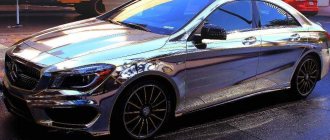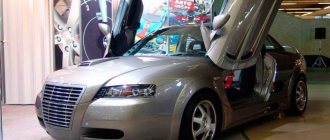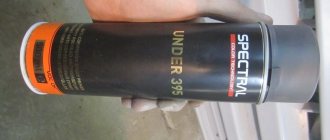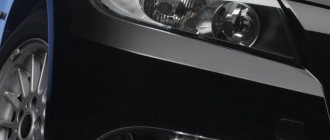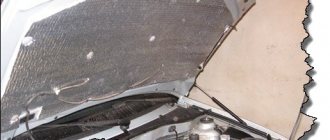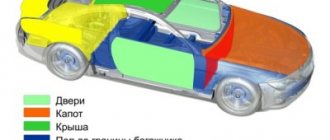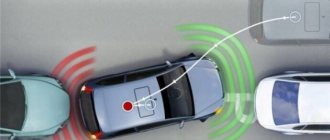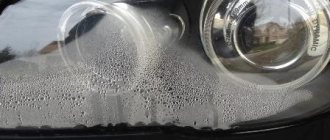Headlights are one of the most vulnerable elements of a car. Their damage affects not only their appearance, but also their driving safety. Small stones, sand, and tree branches gradually lead to the formation of small chips and scratches on the surface of the headlight. Because of this, the light begins to scatter and visibility deteriorates.
If this has already happened, you can do polishing, but this is an expensive service that you don’t want to resort to constantly. There is a cheaper way - take care of the safety of the lighting elements in advance and make a reservation for the headlights. We'll tell you more about it and give step-by-step instructions.
Which film to choose for headlight reservations
All protective films that cover lighting fixtures are made of polyurethane or vinyl.
Vinyl films are cheaper than polyurethane films. In addition, such products are available in a more diverse color palette. They have a thin structure, so they are easier to work with at home.
For headlights with a curved surface, it is better to choose polyurethane. For such optics, armoring headlights with polyurethane film will be easier than applying vinyl. In addition, polyurethane better protects the lighting fixture from mechanical damage.
Vinyl film from the Canadian brand Ricochet is highly elastic and is suitable even for working with headlights of complex configurations. One of the best polyurethane materials is the American Venture Shield film, which is very easy to apply to any surface.
If you choose material from lesser-known manufacturers, check it before purchasing. Low-quality film emits a strong smell of glue, and it breaks when stretched.
Regardless of the material, headlight armoring with protective film follows the same pattern.
What car seats need to be booked?
Car armoring with film does not imply complete wrapping of the car, but on the contrary, it is intended for local application to certain places - those that are most susceptible to impacts and mechanical damage. These include:
- the hood is its central part;
- windshield;
- radiator and bumper;
- headlights and mirrors;
- thresholds, door handle areas.
It is imperative to use PTF film armoring, as well as conventional headlights, since the functionality of the coating provides double protection. In addition to eliminating mechanical damage, the possibility of cracking after impact is completely eliminated.
Headlight reservation: pros and cons
Advantages:
- Extends the life of the headlight as it protects it from minor damage.
- Even in the event of a strong impact, the glass does not fall onto the road, but remains inside the film.
- Various color options allow you to personalize your vehicle design.
Flaws:
- Deterioration of light transmittance.
At the initial stage, light transmittance is reduced only if you use low quality film. Of course, over time, scratches will appear on any film and it will need to be replaced, but this will not happen immediately. In addition, polyurethane has the ability to recover from minor damage, so it lasts longer than vinyl.
- Appearance of yellowness.
It is believed that over time, transparent films, especially polyurethane films, begin to yellow. This can only happen with low-quality material that changes its properties under the influence of xenon lamps and ultraviolet radiation.
Passing MOT and possible punishment
How to tint headlights with film
Car owners who want to do tuning often think about whether it is possible to tint headlights with film. It is impossible to answer this question unequivocally, the point is not spelled out in the Code of Administrative Offences, but still the owner of the car can be punished. Each case is considered separately.
Difficulties may arise when passing a technical inspection. On the one hand, the law does not punish tinting headlights, but on the other hand, lighting devices must meet a number of requirements specified in GOST. During maintenance, they are necessarily checked for light transmittance, mechanical damage, size compliance, presence of foreign elements and other parameters. If the light transmittance of the headlights is below 85% due to the film, you will not be able to pass the MOT.
If the headlights are tinted with film, the fine can vary within several thousand rubles. Punishment is imposed only in cases where the light transmission capacity is greatly reduced and the car can create an emergency situation on the road. Such cars are classified as faulty or those whose operation is prohibited. According to the Code of Administrative Violations, fines are imposed in the following amounts:
- 3000 rubles for individuals;
- up to 20,000 rubles for officials responsible for operating the vehicle;
- up to 500,000 rubles for legal entities.
For driving a car with tinting, the driver can be fined 500 rubles if the lighting devices do not transmit enough color. If the color red is used on the headlights, the driver may be disqualified from 6 to 12 months.
For tinting rear headlights with film, the fine does not exceed 500 rubles, but in practice it is usually not charged.
And although the law does not provide for punishment for tinting lighting fixtures, it is worth assessing all the risks before applying it. If you want to protect lighting devices from damage, you should choose transparent film. If the main goal is tuning, you should pay attention to the choice of material and refuse to purchase a dark-colored option, which significantly impairs the passage of light.
Reserving headlights with film: step-by-step instructions
Step 1: Preparing the Headlights
It is advisable to remove the headlights. If dismantling is too difficult, the reservation can be done directly on the vehicle. The headlights must be washed thoroughly with detergent and dried. If they are old and there are microcracks on the surface, you need to polish them first. To do this, it is better to use the services of a car repair shop, but you can polish the headlight yourself using abrasive paper or polishing paste.
Step 2: Preparing the Film
Using scissors, a utility knife or a thin blade, make a blank from the film. Ideally, you need to measure it so that it covers the entire surface of the headlight and protrudes 1.5-2 cm on each side.
Step 3: working with the form
The headlight has a convex surface, so you need to not just glue it, but pre-stretch the film. To do this, you need to place it on the glass and heat it with a hairdryer - then it will take the desired shape. After this, the entire surface must be degreased with alcohol.
Step 4: Fixing the Film
There is a protective layer above the film, which must be separated from the edge by 3-4 cm and at this point the film must be glued to the glass. Next, heat the glued area with a hairdryer and level the surface with a rubber spatula. Gradually glue the film in 3-4 cm strips using a hairdryer and spatula.
Step 5: Finishing Touches
Carefully cut off the protruding parts of the film, leaving 3-5 mm around the entire perimeter. A thin blade is ideal for cutting. Next, heat the edge with a hairdryer and bend it using a thin object. If you removed the headlight, reinstall it.
Necessary materials
To do the gluing yourself you will need:
- stationery knife;
- squeegee made of rubber or plastic coated with felt (felt);
- spray;
- car shampoo (detergent);
- clean rags;
- construction hair dryer;
- degreaser (alcohol, white spirit, window cleaner).
Before you start working, familiarize yourself with the characteristics of the material and decide whether its color matches the color of the cars.
Also, decide how exactly you will apply the film. As a rule, it is glued evenly, occupying the entire area of the glass of automotive optics. However, if you wish, you can tint only the “eyelashes on the headlights” or combine several colors of the material.
Important nuances
- After you have booked your car headlights, you need to avoid getting the film wet for two days. Do not wash your car or leave it outside in rainy weather.
- The film will deteriorate faster if you wash the surface with powder or abrasive agents, so use soap for washing. Also, do not direct the jet of a high-pressure apparatus at the headlights.
- Global manufacturers promise that the material will last about 5–7 years, but in Russian road conditions this period is reduced to 3–4 years.
To correctly make headlight film reservations with your own hands, we recommend that you first watch training videos.
Approach this issue with caution
What are the disadvantages? The anti-gravel film on the headlights dissipates the STG line, resulting in blinding oncoming cars. Scattering also results in loss of light beam, which causes inconvenience to the driver. Therefore, if the decision is made in favor of booking, then what kind of film should be used to cover the car headlights?
It is best to do this with polyurethane. It is absolutely smooth, without its own shagreen. As a result of pasting, the light beam does not change. Vinyl is best used for additional protection of other parts of the car. On car enthusiast forums there are different opinions about whether it is possible to glue film to car headlights.
But at least most owners agree on one thing. Polishing the headlights and covering them with film, using protective elements such as covers, using film for the rear lights - all this preserves the appearance and makes the car respectable if sold.
About additional benefits of booking
By themselves, the protective films used to protect headlights do not have any particular strength, but due to the uniform distribution of the load when hit by a stone or other object, the headlight can maintain its integrity and not even get chipped or scratched.
Ill-wishers will also not be able to damage the glass of your headlights if they try to scratch them. The armored film applied to the headlights protects the surface from dust and dirt, which can cause damage when washing the glass. In addition, the film will greatly facilitate the process of washing headlights, which will allow you to keep them clean, and clean headlights illuminate the roadway much better at night.
Review of popular products
This protective vinyl material is highly transparent and durable. It is recommended to stick Ricochet both on headlights and on other parts of the car: bumper, handles, body, etc. Armored films for headlights Ricochet protect any parts of the car from wear, scratches, gravel, cutting and piercing objects. This coating can be cleaned with cold water and soapy water.
Ricochet products are particularly flexible and are ideal for complex headlight configurations. The operating temperature for the sticker is from +15 degrees. During operation, the heated material can be moved along the surface in different directions. The price per linear meter is from 955 to 2,895 rubles (depending on thickness).
3M Venture Shield (USA)
This polyurethane material is the leader in the global automotive industry. Venture Shield perfectly protects any car parts from chips, scratches and cracks. Film armor of headlights made of highly elastic polyurethane material provides high-quality protection against gravel, sand and dirt. The manufacturer guarantees five-year operation of the material without loss of quality: the armored film will not slip, delaminate or turn yellow over time. After removal, there will be no traces of glue or adhered particles of material left on the surface.
Watch a video of effective protective vinyl:
A special feature of Venture Shield products is that the armor film is immune to UV rays; its flexibility and elasticity allows it to cover surface areas of the most complex configuration. At the same time, the film does not bubble or warp. Venture Shield is used on Formula 1 cars. Price per linear meter - from 1,675 rubles.
How does anti-gravel film work?
Anti-gravel films are not particularly durable, but nevertheless reliably protect headlights from stone impacts. How does this happen? The fact is that the special composition and manufacturing technology allows the anti-gravel film to redistribute energy upon impact. When a stone hits a clean headlight, it acts in a targeted manner, applying all its energy to one spot. The load at this point becomes too high, resulting in a scratch, chip or even hole. But when a stone hits the anti-gravel surface, its energy is evenly distributed over the entire surface of the headlight, as a result of which the load at each specific point is significantly reduced.
protective film distributes energy evenly over a large surface area
Anti-gravel film can protect almost the entire surface of the car, as it preserves the paintwork very well. But first of all, it is worth pasting over the optical system, since the quality of lighting largely depends on its integrity. And while it’s quite possible to drive with a scratched body, it’s no longer worth it with a broken headlight.
I've been driving armored headlights for 2 years. Does not turn yellow. No scratches or damage are visible. The plastic headlight has become more transparent due to the armor. It shines brighter than before. Over the course of two years, about 10 chips were repaired on the windshield. The hood and bumper also have chips. We have a lot of pebbles on our asphalt roads. The headlight is in excellent condition.
044
https://forums.drom.ru/general/t1151206491.html
In my case, having armor turned out to be useful. Having bought a car already with armor and having driven it for a certain number of years, I decided to remove or leave this film from the headlights. The reason was a slight dimness of the headlights and I wanted to give the “car eyes” a more youthful appearance. While I was driving and thinking, I caught a stone from an oncoming car in my headlight - the armor saved me. Although then I took it off anyway and so far I don’t regret it, and the xenon became really brighter.
audim767
https://www.audi-club.ru/index.php?threads/bookirovanie-far-obsudim.206623/page-2
In addition, in the event of a fairly powerful impact, for example, during an accident, such protection will be able to temporarily hold the broken parts of the headlight together. You can safely drive to the car service center, lighting your way, and then have everything completely repaired.
Video: crash test of anti-gravel film
Characteristics of protection film
Interestingly, metal grilles were previously used to protect headlights. Such armor looked natural on a sports car or jeep. But on elite luxury cars, the grilles spoiled the overall appearance. With the advent of vinyl films, the situation resolved itself: practical and beautiful. How can headlight reservation film help a car?
According to its characteristics, such armor does not have high strength, however, it also has its advantages:
- Reduces impact energy;
- Protects from dust;
- Easy to clean;
- Protects the lamp from damage.
When a large stone hits, the film distributes the energy of the directed impact over the entire surface, which significantly reduces its force. In some cases, the headlight may remain intact. But even if the glass breaks, the fragments will not fly out, but will remain under the film.
Watch the video, the effectiveness of the film:
When cleaning from contaminants, it is easier to wash off rain stains, stuck midges and dirt from a smooth film than from a ribbed glass surface. Scratches from tree branches will remain on the film itself, not on the glass. In this case, the film is simply replaced with a new one.
Is the light intensity reduced when using armored film for headlights? Transparent vinyl and polyurethane do not affect the brightness of the lamps: light transmittance is 97%. Don't forget to clean the surface of the headlights and everything will be fine.
Is tuning legal for headlights?
This is what a tinted taillight looks like (left)
Traffic regulations are the main regulatory document on the road. They should be followed and used as an argument in communication with the inspector, because appealing to “common sense” is usually useless. Section 3 of the rules contains a list of conditions prohibiting the operation of vehicles. In our case, point number 3.6, which regulates the use of lighting devices, is of interest. It states that it is prohibited to install devices and devices whose glow (reflection) color differs from the following:
- Front, for 1.1. Lighting devices - white, yellow, orange.1.2. Retroreflective devices (reflectors) - white.
- Rear, for 2.1. Reversing lights – white.2.2. Illumination of the state registration plate - white.2.3. Other lighting devices - orange, red, yellow.2.4. Retroreflective devices - red.
As usual, the driver will think that “everything that is not prohibited is permitted,” but the guy, on the contrary, will think that what is not permitted is prohibited. But the above excerpt is all that is said in the traffic rules on this issue: neither subtract nor subtract. It’s up to you to solve the “Hamlet’s dilemma”: to tint the headlights or not to tint.
Advantages and disadvantages
Tinting rear or headlights with film has a number of advantages:
- Easy to do. You can do the procedure yourself without spending money on the services of a specialist.
- Cleans up easily. This is especially true in proceedings with traffic police officers.
- The film is available in different colors. It is not difficult to choose a material to match the color of the car.
- Does not wear off during use. Retains aesthetic characteristics for a long time.
- Performs a protective function. Prevents scratches and chips on lighting fixtures.
- Forms a smooth surface. Provides uniform light dispersion.

